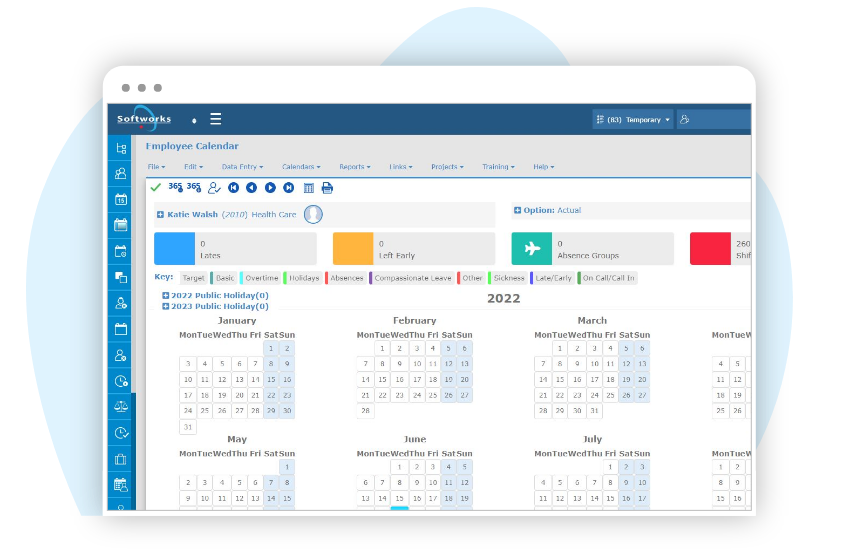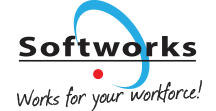Softworks Workforce Management Software lets you easily manage flexible working options like Flexitime, Hybrid Working, Part-time and Remote Working.
Flexible Working

- · Improve Work-Life Balance
- · Increase Staff Motivation
- · Reduce Stress
- · Improve Productivity
- · Reduce Absence
- · Enhance Scheduling
Flexible Working aka. Flexitime is when an organisation offers its employees the opportunity of flexible working hours arrangements. A Flexitime system offers employees more flexibility in the workplace by giving them the option to start and finish work at times that suit their transport arrangements, family responsibilities etc.
Use Softworks Workforce Management Software to facilitate and manage Flexible Working!
Benefits of Flexible Working
- Improved Work-Life Balance
- Increased staff motivation and morale
- Reduced stress
- Improved productivity
- Reduced staff absence
- Better customer service
- Enhanced recruitment and retention
- Improved coverage and scheduling
Flexible Working types
With Softworks Time and Attendance Software, all working hours are captured to the minute. Work patterns are set up within the system to cater for Flexitime – hours worked over the standard week hours will be put into a Flexi balance. Employees can check their Flexi balances using Softworks Employee Self-Service App on their Mobile or Desktop and take time off or work more hours accordingly.
Frequently Asked Questions
What is Flexitime and Flexible Working?
Flexitime refers to a flexible work arrangement where employees have the flexibility to choose their start and end times within certain core working hours. It allows employees to have more control over their work schedules and promotes a better work-life balance.
Flexible working, on the other hand, is a broader term that encompasses various flexible work arrangements beyond just flexitime. It can include options such as part-time work, job sharing, remote work, compressed workweeks, and more, where employees have the flexibility to adjust their work hours, location, or patterns to better suit their needs.
What are examples of flexible work arrangements?
Examples of flexible work arrangements are:
– Flexitime: Employees have the flexibility to choose their start and end times within a specified range of core working hours.
– Remote work: Employees have the flexibility to work from a location other than the traditional office, such as from home or a coworking space.
– Compressed workweeks: Employees work their full-time hours over fewer days, such as working four 10-hour days instead of five 8-hour days.
How to manage Flexitime in an organization?
Managing Flexitime in an organization involves several steps, including:
1. Establishing policies and guidelines: Define the rules, core working hours, and parameters for flexitime arrangements in the organization’s policy.
2. Communication and training: Communicate the flexitime policy to employees and provide training on how to request and manage flexitime effectively.
3. Time tracking and recording: Implement a system to track and record employee hours, ensuring accurate attendance and adherence to flexitime arrangements.
4. Monitoring and compliance: Regularly review and monitor employee adherence to flexitime policies and address any issues or concerns that may arise.
5. Evaluation and adjustment: Continuously assess the effectiveness of the flexitime program and make adjustments as needed to meet employee needs and organizational goals.
What is Flexi balance?
Flexi balance refers to the accumulated time that employees have either gained or used within their flexitime arrangement.
It represents the difference between the total hours worked and the core hours required. If an employee has worked additional hours beyond the required core hours, they may have a positive flexi balance. If they have worked fewer hours, they may have a negative flexi balance.
How can employees check their Flexi balances?
Employees can check their Flexi balances through the Softworks Employee Self-Service on their Desktop PC or through the Softworks Self-Service App on their mobile.
How is Flexitime tracked?
Flexitime is tracked seamlessly through the Softworks Time and Attendance Software. All working hours are captured accurately, down to the minute, using various clocking methods such as biometric clocking terminals or a Softworks Employee Self-service mobile app.
The system automatically calculates and accumulates flexitime hours beyond the standard week, creating a Flexi balance for each employee.
Related Content
What We Do – The Softworks Story…
From Time and Attendance Tracking to a complete Workforce Management Solution…




















